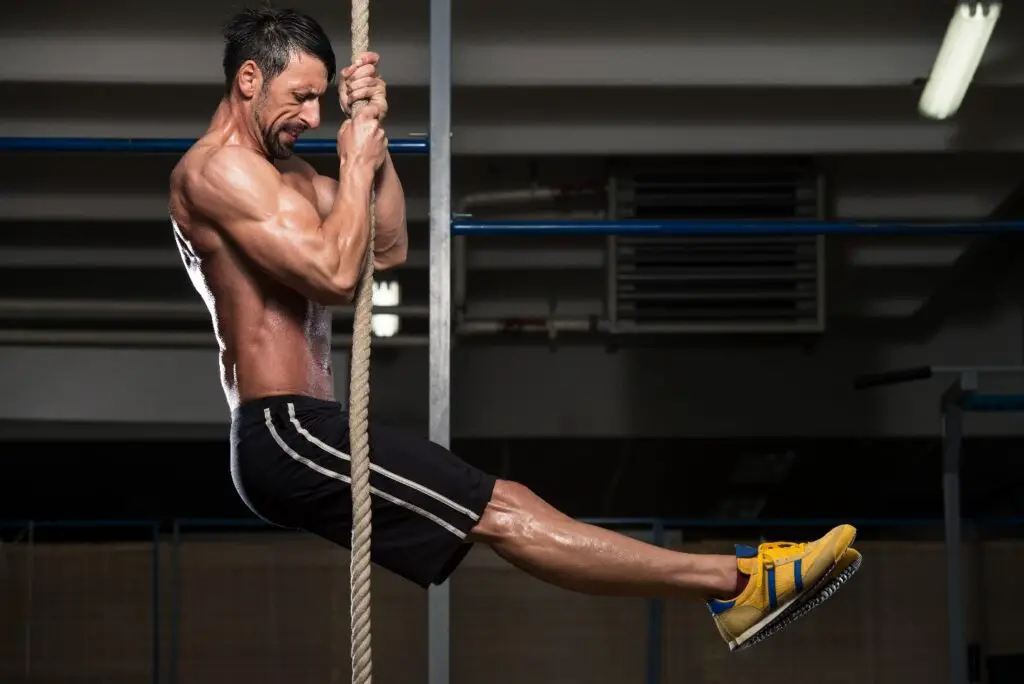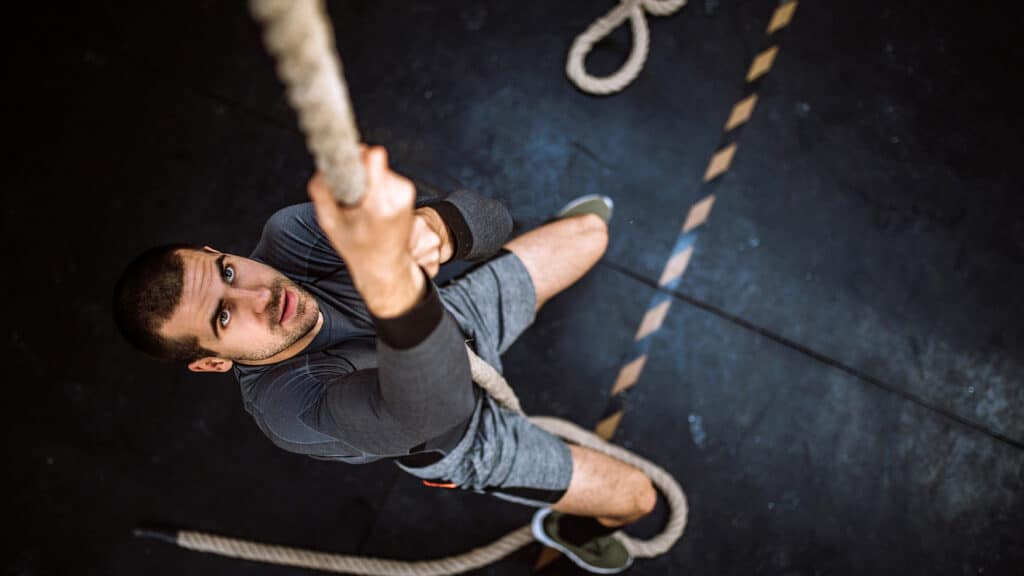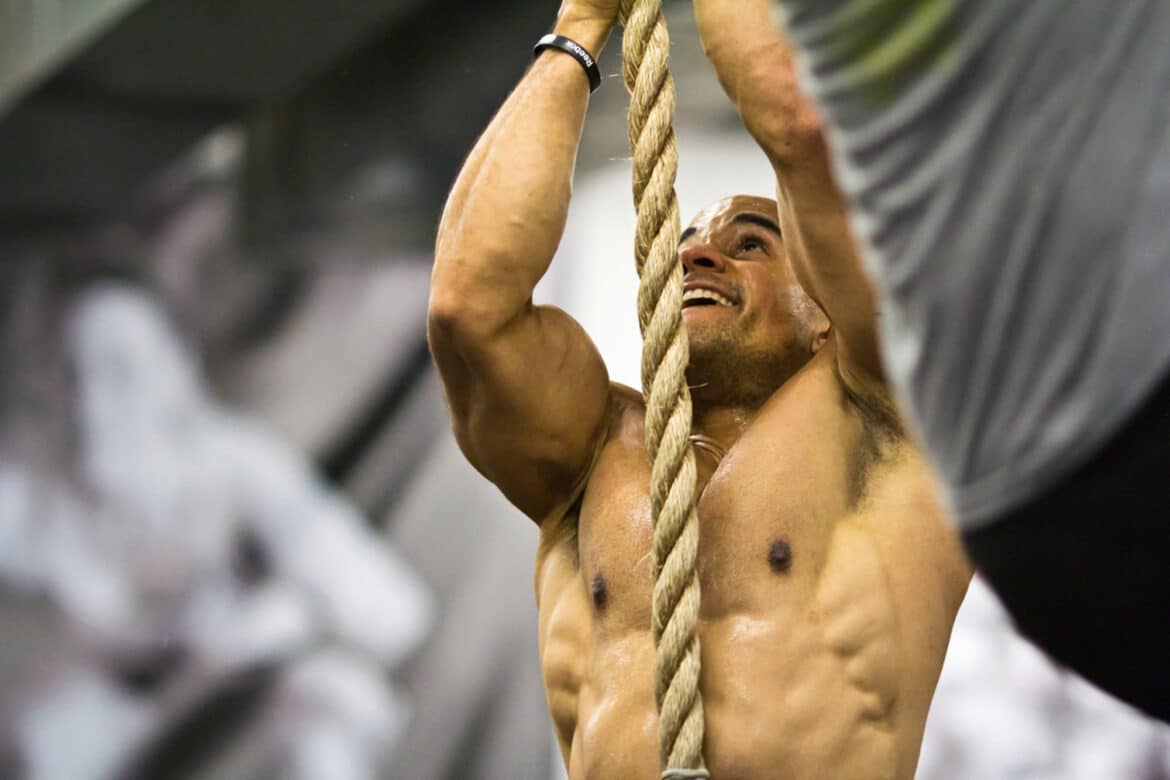Introduction
How To Rope Climb Crossfit: Rope climbing has its roots in functional fitness and is deeply ingrained in CrossFit culture. It draws inspiration from traditional military training and the necessity to navigate obstacles quickly and efficiently. CrossFit founder Greg Glassman recognized the value of rope climbing as a full-body workout that tests one’s physical and mental prowess. As a result, it became an integral part of the CrossFit methodology, emphasizing the development of upper body strength, grip endurance, and overall body coordination.
Rope climbing offers a plethora of benefits that align with the core principles of CrossFit. It engages multiple muscle groups, including the arms, shoulders, back, and core, promoting functional strength and stability. Moreover, rope climbing serves as a formidable cardiovascular challenge, pushing athletes to elevate their heart rates and enhance endurance. Perhaps most importantly, conquering the rope builds mental resilience, as climbers face their fears and learn to overcome obstacles, a mindset essential in CrossFit’s demanding workouts.
To begin your rope climbing journey in CrossFit, you’ll need access to a sturdy climbing rope and a safe environment. Proper technique is essential to ensure both safety and efficiency. Key elements include learning various foot-locking methods, maintaining a secure grip, and developing a rhythmic motion for climbing.

How to do rope climb?
The J Hook
This is a much faster way to get to the top of the rope than the Spanish Wrap. To do it, you’ll need to clamp your feet together, which creates a ‘J’ with the rope. Then squeeze the clamp together on your way up – this is a much quicker way of getting in and out of the clamp as you’re climbing.
Inspect the rope: Check the rope for any signs of wear and tear, such as frayed or damaged areas. Replace any damaged ropes immediately.
Proper attire: Wear comfortable clothing that allows for a full range of motion. Gloves can protect your hands from friction burns.
Secure the rope: Make sure the rope is anchored securely at the top to prevent it from coming loose during your climb.
Pull-ups: Incorporate pull-ups into your workout routine to strengthen your arms, shoulders, and back.
Hanging leg raises: These exercises target your core and grip strength, both crucial for rope climbing.
Push-ups: Strengthen your chest, triceps, and shoulders to assist with the pulling motion of the climb.
What are the standards for rope climb in CrossFit?
ROPE CLIMB
The rep is credited when one hand clearly touches above the designated mark. Athletes may choose to touch a fixed object, such as a beam or the ceiling, so long as the object is at least 15 ft (4.57 m) high. There is no requirement during the descent of the climb.
Rope Height and Length
In CrossFit, rope climbs are typically performed on ropes that are suspended from the ceiling or a secure anchor point. The height of the rope can vary, but it’s usually set at a height that requires athletes to jump or perform some form of dynamic movement to reach the rope. The standard rope length is typically 15 feet (4.5 meters). Athletes are expected to climb to the top of the rope and touch a designated marker, often a crossbeam or the ceiling.
Legless Rope Climbs
CrossFit distinguishes between two types of rope climbs: leg-assisted and legless. Leg-assisted rope climbs allow athletes to use their legs to help propel themselves upward. In contrast, legless rope climbs require athletes to use only their upper body strength to ascend the rope. The standards for legless rope climbs are often more stringent, as they demand greater upper body strength and technique.
Time and Repetitions
In CrossFit workouts, rope climbs are often incorporated as part of a larger set of exercises. Athletes may be required to complete a certain number of rope climbs within a specified time frame. For example, a workout might call for three rope climbs as quickly as possible, or it may require a specific number of repetitions (e.g., 5, 7, or 10 rope climbs) in a set amount of time.
How do I get strong enough to climb a rope?
Work On Upper-Body Strength
Any kind of exercise that works your lats, shoulders, or biceps such as a pull-up, bicep curl or row with a dumbbell, barbell, or kettlebell will translate to a stronger rope climb, he says.
Increase Flexibility:Rope climbing also requires flexibility. Work on your hip and ankle mobility to make it easier to wrap your legs around the rope when climbing.
Consistent Practice:Consistency is key to building the strength and technique necessary for rope climbing. Dedicate regular sessions to rope climbing practice, gradually increasing the height and difficulty as you progress.
Safety Measures:Always ensure you have a safe environment for rope climbing. Inspect the rope for any wear or damage, wear appropriate footwear, and consider using gloves to protect your hands from friction burns.
Patience and Progression:Rope climbing is a skill that takes time to develop. Be patient with your progress and celebrate each milestone along the way.
Why is rope climbing so hard?
Vertical grip positions, such as rope climbs or using Monkee Grips for farmers carries and pull ups, require not only grip strength but also coordination of the muscles within the hand and wrist to manipulate the rope.
Full-Body Engagement: Rope climbing engages a wide range of muscle groups simultaneously. Unlike some exercises that isolate specific muscles, rope climbing demands the coordination and strength of multiple areas of the body, including the arms, shoulders, back, core, and legs. This comprehensive engagement makes it physically demanding, as it requires well-rounded strength and endurance.
Grip Strength: A strong grip is essential for rope climbing. Maintaining a secure hold on the rope is challenging, especially as fatigue sets in. The rope’s texture and thickness can vary, further testing your grip strength. Building and maintaining a solid grip while ascending is a key challenge in rope climbing.
Lack of Lower Body Support: Rope climbing differs significantly from climbing a ladder or staircase because it doesn’t provide the support of your lower body. You must rely on your upper body strength and technique to propel yourself upward. This reliance on upper body strength alone increases the difficulty.
Technique: Proper rope climbing technique is crucial, and mastering it can be challenging. A lack of technique can result in inefficiency and wasted energy. The correct method involves using both arms in a coordinated manner while simultaneously using your legs to secure the rope. This technique can take time to develop and execute effectively.
Cardiovascular Endurance: Rope climbing can be physically exhausting, particularly during longer climbs or when it’s part of a high-intensity workout. It challenges your cardiovascular system, requiring sustained effort and oxygen delivery to working muscles. Poor cardiovascular endurance can make rope climbing feel especially hard.
Can you rope climb alone?
An advanced climbing technique, top rope solo climbing requires you to self-belay and removes the participation of a climbing partner, who would normally belay you or otherwise assist you as you climb.
Inform Someone:Always let someone know that you are going to be rope climbing alone, especially if you’re doing it in a remote or isolated location. Share your plans, expected duration, and your location with a friend or family member. This ensures that someone is aware of your activity and can come to your aid in case of an emergency.
Maintain a Controlled Environment:Choose a safe and controlled environment for your rope climbing activities. Climbing in a gym or a well-maintained climbing facility with appropriate safety measures is preferable, especially if you’re new to rope climbing.
Regular Safety Checks:Before each climb, inspect the rope, harness, and any safety equipment you are using to ensure they are in good condition. Pay attention to knots, anchor points, and any signs of wear and tear.
Start Slow and Gradual:If you’re new to rope climbing, begin with low heights and short climbs. As you gain confidence and experience, you can gradually increase the difficulty and height of your climbs.
Learn Self-Rescue Techniques:Familiarize yourself with self-rescue techniques, such as ascending and descending on the rope using various knots and devices. Being able to handle unexpected situations or equipment failures is crucial when climbing alone.
Can the average person climb a rope?
Yes. Anyone capable of climbing a ladder can climb a rope.
Physical Fitness Level:Rope climbing does require a certain level of physical fitness, but it’s not limited to elite athletes. The average person can certainly develop the necessary fitness over time. A basic level of upper body strength, grip strength, and core stability is a good starting point. If you can do pull-ups, push-ups, and hanging leg raises comfortably, you have a solid foundation to begin rope climbing training.
Proper Technique:Learning and applying the correct technique is crucial for successful rope climbing. Proper technique minimizes wasted energy and maximizes efficiency. This technique involves using both arms in a coordinated manner while simultaneously using your legs to secure the rope. It may take time to develop this skill, but it’s essential for safe and effective climbs.
Training and Progression:Rope climbing is a skill that can be developed progressively. Start with low heights or partial climbs and gradually work your way up to more challenging climbs. Consistent practice and incremental progression are key. A well-structured training program can help you build the strength and technique required for rope climbing.
Safety Considerations:Safety should always be a top priority when rope climbing. Ensure that the rope is anchored securely at the top and that it’s in good condition, free from frays or damage. Wearing the right equipment, such as a climbing harness and gloves, can help protect you from injury. Additionally, consider using a safety backup system, such as a prusik knot or a mechanical rope grab, when climbing alone.
Are legless rope climbs hard?
More videos on YouTube
Legless rope climbs are considered very advanced because they rely solely on upper body strength, requiring both strong upper body and core muscles.
Upper Body Dominance: The most striking feature of legless rope climbs is the complete absence of leg support. In a standard rope climb, you use your legs to assist in propelling yourself upward. In a legless climb, however, you rely solely on your upper body strength. This means your arms, shoulders, back, and core muscles must bear the entire load of lifting your body weight.
Grip Strength: Legless rope climbs place tremendous demands on your grip strength. Without the ability to use your legs for assistance, maintaining a secure grip on the rope throughout the climb becomes even more challenging. Grip strength is crucial not only for ascending but also for preventing sudden descents, which can be dangerous without leg support.
Technique Mastery: The technique required for legless rope climbs is highly specialized. It involves an efficient hand-over-hand motion while minimizing the expenditure of energy. Perfecting this technique is not easy and often requires dedicated practice to ascend smoothly and avoid exhaustion early in the climb.
Core Strength and Stability: With the absence of leg support, your core muscles play a pivotal role in maintaining stability and control during legless rope climbs. A strong core helps you keep your body in the proper position and prevents excessive swinging or twisting, which can lead to inefficiency and loss of energy.
How heavy are CrossFit ropes?
ACCOMMODATES ALL FITNESS LEVELS: These 1.5” heavy ropes for exercise training are available in lengths of 30 or 50 feet. The shorter conditioning rope is great for those new at rope training, with the longer one challenging intermediates and pros. The 50 ft. = roughly 32lbs, the 40ft = 25lbs and the 30ft = 18lbs.
Battle Ropes
Weight: Battle ropes come in various lengths and thicknesses, which affect their weight. The most common battle rope diameters are 1.5 inches and 2 inches, and they typically range from 30 to 50 feet in length.
Purpose: Battle ropes are used in CrossFit for high-intensity interval training (HIIT) and strength and conditioning exercises. The weight of a battle rope is primarily determined by the diameter and length. Thicker and longer ropes are heavier and provide more resistance during workouts.
Workouts: CrossFit athletes use battle ropes for a variety of exercises, such as waves (creating a wavelike motion with the ropes), slams (lifting and slamming the ropes to the ground), and spirals (rotating the ropes in different patterns). The weight of the rope influences the intensity of these exercises.
Climbing Ropes
Weight: Climbing ropes used in CrossFit typically have a standardized weight, which is determined by their diameter and length. The most common diameter for CrossFit climbing ropes is 1.5 inches.
Purpose: Climbing ropes are used for rope climbing exercises in CrossFit, where the primary focus is on strength and technique. The weight of the climbing rope is mainly determined by its diameter.
Workouts: CrossFit incorporates rope climbing as a functional and challenging exercise that builds upper body and grip strength. Athletes must lift their entire body weight during rope climbs, making it a demanding workout. While the weight of the rope itself is not variable, the workout intensity is determined by the height of the climb and the number of repetitions.

Conclusion
One of the key takeaways from our discussion is that rope climbing is more than just a physical exercise; it’s a mental challenge that builds resilience and character. Overcoming the initial fear of ascending a rope, mastering different climbing techniques, and pushing your physical limits fosters mental toughness and self-confidence. These qualities are not only valuable in the CrossFit box but also in everyday life.
Rope climbing contributes significantly to CrossFit’s core principles of functional fitness and versatility. By engaging various muscle groups and promoting full-body coordination, it aligns perfectly with CrossFit’s commitment to well-rounded athleticism. Additionally, the cardiovascular demands of rope climbing make it an excellent tool for improving endurance and stamina, two critical components of any CrossFit workout. The journey of rope climbing in CrossFit is inclusive. Athletes of all skill levels can participate, starting with scaled versions of the exercise and gradually progressing to more challenging climbs. This inclusivity fosters a sense of community within the CrossFit box, as athletes support and motivate one another to reach new heights, quite literally.
To excel in rope climbing within the CrossFit context, continuous training and dedication are essential. Supplementing your rope climbing sessions with grip strength exercises, pull-ups, and core workouts can significantly enhance your performance. That progress takes time, and setbacks are part of the journey. Embrace these challenges as opportunities for growth, both physically and mentally.

